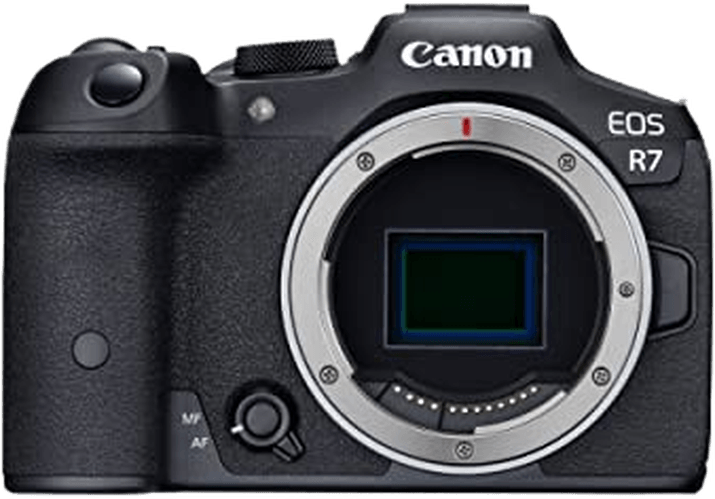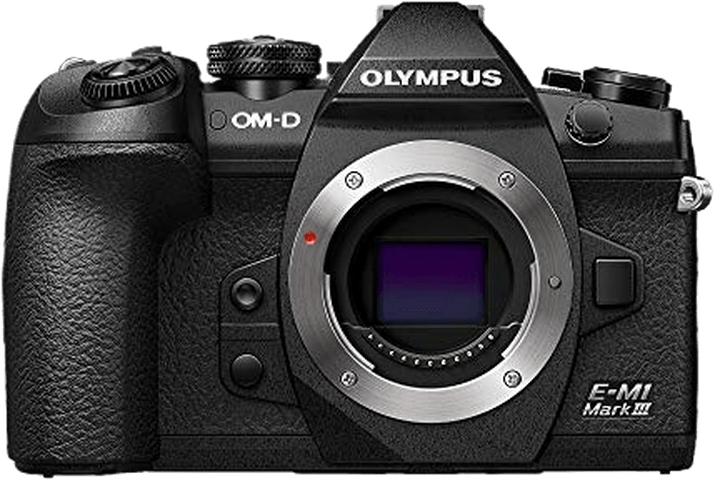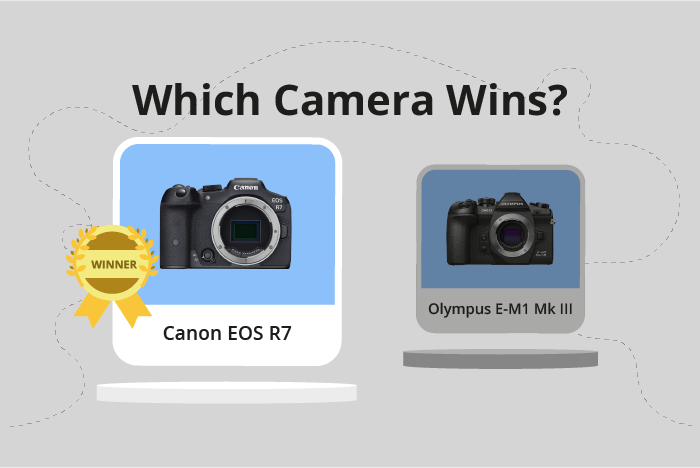Canon EOS R7 vs Olympus OM-D E-M1 Mark III Comparison
Canon EOS R7

Olympus OM-D E-M1 Mark III

The Canon EOS R7 outperforms the Olympus OM-D E-M1 Mark III with a score of 83/100 compared to 72/100. Both cameras are mirrorless and share similar dimensions, with the R7 measuring 132 x 90 x 92mm and the E-M1 Mark III at 134 x 91 x 69mm. The R7 is slightly heavier at 612g compared to the E-M1 Mark III’s 580g.
The Canon EOS R7 excels with its higher score, launched in 2022 at a lower price of $1500 compared to the E-M1 Mark III’s $1799 price tag from 2020. The R7’s better performance and more recent release make it a more attractive option for buyers.
On the other hand, the Olympus OM-D E-M1 Mark III has the advantage of being lighter by 32g, which could be beneficial for users prioritizing portability. However, considering the overall performance and price difference, the Canon EOS R7 stands out as the better choice between the two cameras.
Canon EOS R7 vs Olympus OM-D E-M1 Mark III Overview and Optics
The Canon EOS R7 outperforms the Olympus OM-D E-M1 Mark III in optics, scoring 82/100 compared to the Olympus’ 68/100. Both cameras share some common specifications, such as CMOS sensor type, image stabilization, and lens mounts compatible with their respective systems. However, there are notable differences that contribute to the Canon’s higher score.
The Canon EOS R7 boasts 33 megapixels, which is significantly higher than the Olympus’ 20 megapixels. This higher resolution provides more detail and better image quality. Moreover, the Canon EOS R7 has a superior DXOMARK sensor score of 97, compared to the Olympus’ 80, indicating better overall sensor performance. The Canon also features an APS-C sensor size, larger than the Olympus’ Micro Four Thirds sensor, resulting in better low-light performance and increased dynamic range.
On the other hand, the Olympus OM-D E-M1 Mark III has a faster shooting speed of 60 frames per second, compared to the Canon’s 15. This advantage allows for better action and sports photography. Additionally, the Olympus features a 4:3 aspect ratio, which some photographers may prefer for certain compositions or printing formats.
Despite the Olympus’ faster shooting speed and unique aspect ratio, the Canon EOS R7 emerges as the superior camera in terms of optics due to its higher resolution, better sensor performance, and larger sensor size. The choice between these two cameras ultimately depends on the photographer’s needs and preferences, but the Canon EOS R7 provides a clear advantage in image quality and overall optical performance.
Canon EOS R7 vs Olympus OM-D E-M1 Mark III Video Performance
The Canon EOS R7 outperforms the Olympus OM-D E-M1 Mark III in video capabilities, with a score of 91/100 as opposed to 83/100. Both cameras share some common specifications, such as 4K maximum video resolution and built-in time-lapse functionality. However, several factors contribute to the Canon EOS R7’s superior video performance.
Firstly, the Canon EOS R7 boasts a higher maximum video frame rate of 120fps compared to the Olympus OM-D E-M1 Mark III’s 60fps. This allows for smoother slow-motion footage and greater flexibility in post-production. Additionally, the Canon EOS R7’s max video dimensions are 3840 x 2160, providing crisp and detailed visuals.
On the other hand, the Olympus OM-D E-M1 Mark III has its own advantage in video dimensions, with a max resolution of 4096 x 2160. This slightly wider aspect ratio creates a more cinematic look, which some filmmakers might prefer. However, the lower frame rate limits the camera’s versatility in capturing fast-moving subjects and producing slow-motion effects.
In comparing the two cameras, the Canon EOS R7 emerges as the better choice for video capabilities due to its higher score, faster maximum frame rate, and crisp image quality. The Olympus OM-D E-M1 Mark III’s advantage in video dimensions may appeal to some users, but it does not outweigh the benefits offered by the Canon EOS R7. Therefore, those seeking a camera with superior video performance should opt for the Canon EOS R7.
Canon EOS R7 vs Olympus OM-D E-M1 Mark III Features and Benefits
The Canon EOS R7 emerges as the winner with a feature score of 85/100, while the Olympus OM-D E-M1 Mark III trails closely behind at 83/100. Both cameras share several specifications, including a 3-inch screen size, touchscreen capabilities, flip screen, absence of GPS, and the presence of WIFI and Bluetooth connectivity.
The Canon EOS R7 outperforms the Olympus OM-D E-M1 Mark III in screen resolution, boasting 1,620,000 dots compared to the Olympus’s 1,037,000 dots. This higher resolution provides a sharper and clearer image display, allowing for better image review and easier menu navigation.
On the other hand, the Olympus OM-D E-M1 Mark III still holds its ground with a slightly lower feature score. Although it doesn’t surpass the Canon EOS R7 in any specific category, it remains a strong competitor with its similar specifications. The difference in screen resolution may not be a significant factor for some users, depending on their preferences and requirements.
Taking these factors into account, the Canon EOS R7 stands out as the better camera in terms of features, particularly due to its superior screen resolution. However, the Olympus OM-D E-M1 Mark III remains a viable option for those who may not prioritize screen resolution and are looking for a camera with comparable features. Both cameras offer a range of capabilities suitable for various photography needs, with the Canon EOS R7 holding a slight advantage.
Canon EOS R7 vs Olympus OM-D E-M1 Mark III Storage and Battery
The Canon EOS R7 outperforms the Olympus OM-D E-M1 Mark III in storage and battery with a score of 79/100 compared to the latter’s 71/100. Both cameras share some common specifications, including two memory card slots and compatibility with SD, SDHC, and SDXC cards. They also both support USB charging.
The EOS R7 has an advantage in battery life, offering 660 shots per charge compared to the E-M1 Mark III’s 420 shots. Additionally, all of the R7’s card slots are UHS-II compatible, while only one slot on the E-M1 Mark III offers this compatibility. These factors contribute to the R7’s higher score in storage and battery.
On the other hand, the E-M1 Mark III still provides decent battery life and storage options despite its lower score. The two-slot memory card system and USB charging capability make it a reliable choice for photographers.
In comparing these cameras, the Canon EOS R7 takes the lead in storage and battery performance due to its longer battery life and full UHS-II compatibility. However, the Olympus OM-D E-M1 Mark III remains a solid option with its similar storage features and adequate battery life.
Alternatives to the Canon EOS R7 and Olympus OM-D E-M1 Mark III
Are you still undecided about which camera is right for you? Have a look at these popular comparisons that feature the Canon EOS R7 or the Olympus OM-D E-M1 Mark III:

